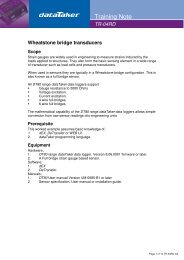Create successful ePaper yourself
Turn your PDF publications into a flip-book with our unique Google optimized e-Paper software.
Data Range: 0 to 8031.875 rpm<br />
Type:<br />
Measured<br />
Suspect Parameter Number: 190<br />
The SNOOPJ command can now be used to verify that the PGN is in fact being broadcast by an ECU on the CAN network.<br />
This involves examining the returned data looking for the required PGN (61444). For example:<br />
SNOOPJ 1<br />
…<br />
EXT 0CF00402 PGN:61444 PRI:3 SA:2 DA:0<br />
…<br />
This line indicates that the required PGN is being broadcast on the network, and decodes the CAN identifier (0CF00402) as<br />
follows:<br />
priority field is 3<br />
PGN field is 61444 (0x00F004)<br />
destAddr field is not applicable because this PGN uses PDU2 format (bits 15-8 of PGN >= 0xF0)<br />
srcAddr (ie. the address of the sending ECU) is 2.<br />
Using this information, a memory slot can be initialised, for example:<br />
RECVJ 1 61444 4 5 2 3 FORMAT 0.125 "%.3f rpm\n"<br />
which will:<br />
receive J1939 messages<br />
on CAN port 1<br />
with identifier 0x0CF00402 (PGN 61444, source address 2, priority 3)<br />
and extract bytes 4-5 as an unsigned 16-bit value (byte 4 = LSB, byte 5 = MSB)<br />
then multiply by 0.125<br />
and, when polled, return the result as a floating point value with 3 decimal places (%.3f)<br />
followed by the text " rpm" and a CRLF (\n).<br />
Note that for J1939, multi-byte fields are always specified LSB first (Intel format). It is not necessary to specify the n option<br />
after the FORMAT for RECVJ/RQSTJ slots.<br />
Request PGNs<br />
Some PGNs are not broadcast; they are only returned when specifically requested. For example, if the above PGN was<br />
actually a "request-only" PGN, the engine speed would then be obtained using:<br />
RQSTJ 1 61444 4 5 2 3 FORMAT .125 "%.3f rpm\n"; RP<br />
which looks very similar to the RECVJ slot definition. The RP on the end causes the memory slot to be immediately polled,<br />
which will cause the request to be immediately sent. (Note that it doesn't make sense to poll a RECVJ slot immediately after<br />
defining it, because at that time it is likely that no matching messages will have been received, in which case nothing will be<br />
returned.)<br />
Reusing Request Data<br />
Often a J1939 PGN will contain several separate parameters (which is why it is called a Parameter Group Number). These<br />
parameters are typically extracted using a number of memory slots, all with the same PGN but with different start and end<br />
bytes specified. The same is true for certain OBD PIDs.<br />
For requested PGNs, it is inefficient for each slot to send a separate request, particularly for multi-packet PGNs. Also, you<br />
may not get a consistent snapshot of all of a PGN's constituent parameters – that is, they may not have been measured at<br />
the same time (which may or may not be a problem).<br />
For this reason, <strong>CANgate</strong> will attempt to reuse requested data where possible, ie. a RQST/RQSTJ slot will use previously<br />
received reply data rather than sending a new request. This will, however, only be done if:<br />
the most recently sent request message exactly matches this slot's request message (ie. it's a request for the same<br />
PGN, same source and destination address and so on), and<br />
this is a different slot to the one which sent the request (or, if this and the requesting slot are both slot #0, then the two<br />
slot definitions are different in some way, eg. they are extracting a different range of bytes), and<br />
the reply data was received less than 5 seconds ago.<br />
The second condition means that if you repeatedly poll a group of slots, each of which extracts a different part of the same<br />
PGN, then only one request will be sent each time the group is polled – provided that the group is polled within 5 seconds.<br />
UM-0086-A2 <strong>CANgate</strong> User’s <strong>Manual</strong> Page 29



